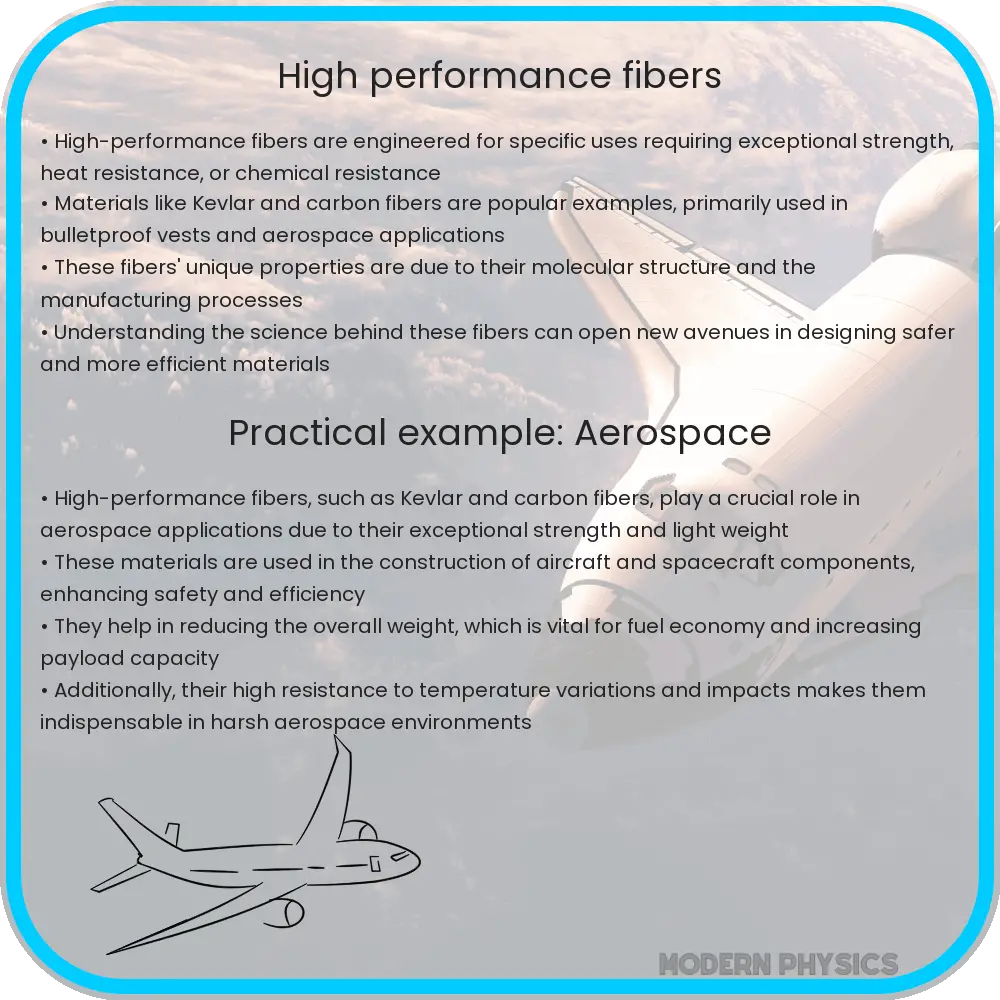Delve into the exceptional qualities of high-performance fibers, celebrated for their strength, durability, and versatility across various industries.

High-Performance Fibers: Durability, Strength & Innovation
In the world of materials science, high-performance fibers stand out for their exceptional durability, strength, and innovative applications. These specialized fibers are engineered to meet demanding requirements in a variety of industries, including aerospace, military, automotive, and sports equipment. This article explores the unique properties of these fibers, how they are made, and some real-world applications that benefit from their remarkable characteristics.
Understanding High-Performance Fibers
High-performance fibers are designed to offer superior strength, modulus (stiffness or resistance to deformation), and resistance to harsh environments compared to ordinary fibers. Commonly used materials include aramids (like Kevlar and Nomex), ultra-high molecular weight polyethylene (UHMWPE), carbon fibers, and glass fibers. Each type of fiber offers unique properties that make it suitable for specific applications.
- Aramid Fibers: Known for their heat resistance and strength, aramid fibers are used in bulletproof vests, firefighting gear, and aerospace components.
- UHMWPE Fibers: These are highly durable and exhibit extremely high resistance to abrasion, making them ideal for use in medical devices and body armor.
- Carbon Fibers: Valued for their stiffness and strength-to-weight ratio, carbon fibers are predominantly used in the manufacturing of high-performance sporting goods and components for vehicles and aircraft.
- Glass Fibers: Glass fibers are primarily used for their insulating properties and high tensile strength in products like circuit boards and various automotive components.
The synthesis of these fibers often involves complicated chemical and mechanical processes tailored to enhance particular properties such as tensile strength, thermal stability, or chemical resistance.
Properties That Define High-Performance
Several key properties are critical when assessing the performance of these advanced fibers:
- Tensile Strength: This is the maximum stress that a material can withstand while being stretched or pulled before breaking. High-performance fibers often exhibit tensile strengths many times that of steel.
- Elastic Modulus: Also known as stiffness, this property measures a material’s ability to deform elastically (i.e., non-permanently) when a force is applied. Higher modulus fibers are less stretchy, which is crucial in applications requiring high dimensional stability.
- Thermal Resistance: The ability to maintain integrity and performance at high temperatures is vital for fibers used in fire suits and aerospace components.
- Chemical Resistance: Resistance to chemicals is essential for fibers used in hazardous environments to prevent degradation and maintain performance over time.
The remarkable properties of high-performance fibers are not just a result of their chemical makeup, but also their micro-structural characteristics. For instance, the molecular orientation and crystallinity of the fibers can significantly influence their strength and thermal stability.
Innovative Applications of High-Performance Fibers
Due to their outstanding properties, high-performance fibers have paved the way for innovations across various fields. In aerospace, they are used to create lightweight composites for aircraft structures that reduce weight while maintaining strength and safety. In sports, carbon fiber composites are used to make lighter, more robust equipment such as tennis rackets, bicycles, and golf clubs, enhancing athletic performance.
In the medical field, high-performance fibers are utilized in the creation of prosthetics and implants that need to withstand the mechanical stresses of the human body without reacting adversely with biological tissues. Furthermore, in the automotive sector, these fibers contribute to increased safety and improved fuel efficiency by reducing the overall weight of vehicles.
As we continue to explore the practical applications of these fibers, their role in driving technological and industrial advancements becomes increasingly evident. The integration of high-performance fibers into new sectors and products promises not only to enhance the performance and efficiency of existing solutions but also to spearhead innovations in engineering and materials science.
Environmental and Economic Impact
As industries globally push towards sustainability, high-performance fibers are also evaluated on their environmental and economic impact. The production processes of these fibers, while intricate, are continually being refined to reduce energy consumption and minimize waste. Recycling and reuse of high-performance fibers are becoming increasingly vital considerations, particularly in industries like automotive and aerospace, which are under pressure to decrease their environmental footprints.
Furthermore, the long-term durability and maintenance savings due to the usage of these fibers contribute positively to their economic viability. This makes high-performance fibers a more attractive option not only from a performance standpoint but also from environmental and financial perspectives.
Future Trends in High-Performance Fibers
Advancements in nanotechnology and bioengineering promise to further extend the boundaries of high-performance fibers. Researchers are exploring the possibility of integrating nanoscale and biological elements with traditional fiber materials to create even more potent and versatile products. These innovations could introduce properties like self-healing, energy harvesting, and advanced biocompatibility, which could transform numerous industries.
The ongoing research and development in improving the production techniques and functionalities of high-performance fibers ensure that they will remain at the forefront of material science innovation, driving progress in numerous technological and industrial fields.
Conclusion
High-performance fibers represent a key area of development in materials science, offering unmatched strength, durability, and versatility. From enhancing the safety of military and aerospace components to advancing sports technology and medical implants, these fibers continue to make significant contributions across various sectors. Alongside their functional benefits, their evolving production processes also reflect an increasing commitment to sustainability and economic efficiency. As we look towards the future, the role of high-performance fibers in fostering technological and industrial innovation is undeniable, promising new applications and improvements in both performance and environmental impact.
